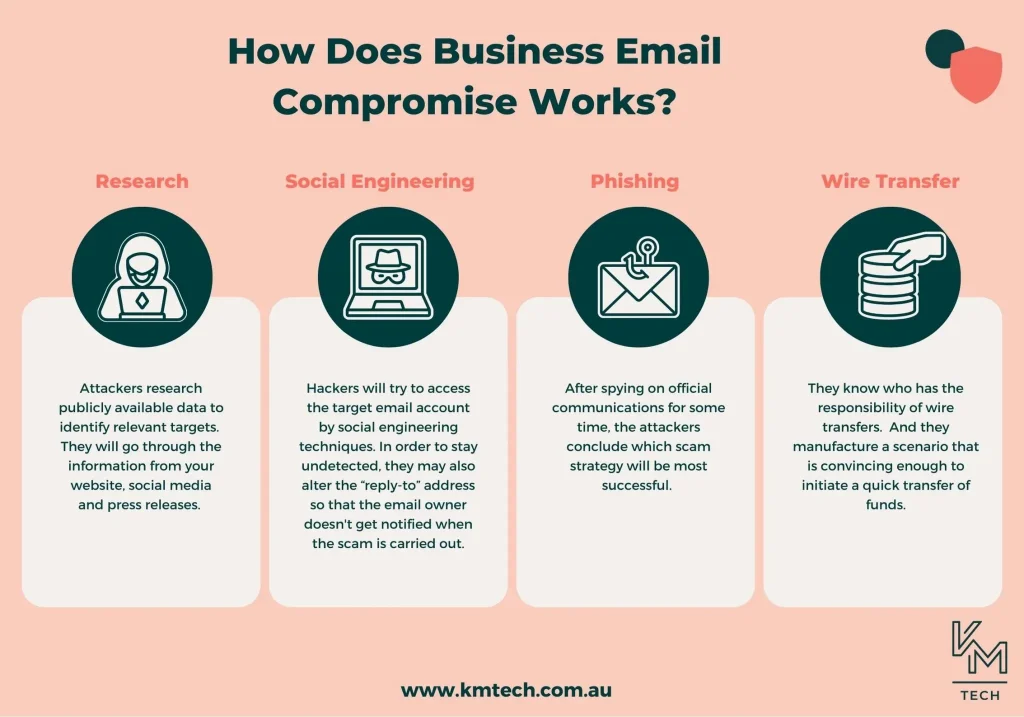Business email compromise (BEC) has emerged as a significant threat to organizations, representing one of the most financially damaging types of cybercrime today. These cybercriminals utilize deceptive tactics such as email spoofing to impersonate authority figures and trusted colleagues, thereby exploiting the inherent trust within corporate environments. With losses exceeding $2.7 billion annually, BEC attacks have eclipsed traditional scams, posing severe risks to both corporate finances and reputations. Unlike straightforward phishing attempts, which often come with clear red flags, these sophisticated strategies can deceive even the most vigilant employees. To combat these cybersecurity threats, comprehensive employee education against cybercrime is essential, ensuring that staff can recognize and respond to potential BEC attacks swiftly.
The phenomenon of corporate email infiltration has taken the cybersecurity landscape by storm, often referred to as business email fraud or CEO phishing. This sophisticated form of attack involves criminals masquerading as trusted figures within a company, creating a façade that can easily mislead unsuspecting employees. By utilizing extensive social engineering tactics, attackers gain valuable insights into organizational hierarchies and communication styles, making their fraudulent requests appear legitimate and urgent. The impact of such corporate hacking incidents can be devastating, leading to significant financial losses and compromised sensitive data. As businesses grapple with these advanced threats, proactive measures, including heightened awareness and training, become crucial to mitigating risks.
Understanding Business Email Compromise
Business Email Compromise (BEC) has emerged as a critical cybersecurity threat, primarily designed to manipulate the trusting relationships forged within organizations. These attacks cleverly exploit the vulnerabilities inherent in human interactions, leading to significant financial losses that rank among the highest in cybercrime. By impersonating trusted colleagues or authoritative figures, criminals can easily trick employees into divulging sensitive information or authorizing fraudulent transactions, generating billions in damages globally.
The landscape of business email compromise highlights a shift from traditional hacking methods to more nuanced social engineering techniques. With these attacks, the true threat is not just the technical breach of systems but the ability to deceive individuals through personalized communication. This makes BEC particularly challenging to combat, as the request for sensitive information or financial transactions may appear entirely legitimate, making even vigilant employees susceptible to falling for these manipulations.
The Evolution of Cybercriminal Strategies
Sophisticated cybercriminals have significantly refined their methods over the years, moving from generic phishing attempts to highly targeted business email attacks. These tactics are a result of extensive research, where attackers gather information from social media platforms and corporate websites to design convincing emails that mimic the communication styles of actual executives. By establishing look-alike domains that closely resemble legitimate company addresses, they increase their chances of success during their attacks.
This evolution signifies a notable shift in the focus of cyber threats from individual data breaches to orchestrated schemes that can compromise entire organizations. The financial implications of this targeted approach are staggering, as a single compromised employee account can grant access to internal financial resources, enabling hackers to redirect funds or steal sensitive corporate information. This role of deception in corporate hacking illustrates the urgent need for comprehensive employee education against such cybercrime tactics.
Detecting Advanced Business Email Compromise
The detection of business email compromise attacks is complicated by the sophisticated strategies employed by cybercriminals. As hackers infiltrate corporate email systems, they often take time to observe and analyze internal communications, waiting for the ideal moment to execute their fraudulent requests. This patient approach enables attackers to develop a deep understanding of company processes, making their requests appear relevant and legitimate.
As a result, traditional cybersecurity measures which focus primarily on identifying malware or suspicious content often fail to catch these types of attacks. Organizations must thus prioritize training and vigilant monitoring of internal communications along with the use of advanced security measures to identify signs of compromise. Employees need to learn how to recognize the red flags of BEC, fostering a culture of caution and due diligence.
Strengthening Cybersecurity Measures
To effectively combat business email compromise, organizations must not only focus on technology but also on cultivating a stronger awareness among employees regarding cybersecurity threats. Implementing a robust employee education program centered around recognizing suspicious activity is essential. Providing regular training sessions that cover the tactics used in business email attacks and emphasizing the importance of dual verification for transactions can significantly reduce the risk of successful attacks.
Additionally, the deployment of multi-factor authentication and strict protocols for financial transactions can further enhance business defenses against BEC. By requiring multiple forms of verification, organizations can thwart potential attempts by criminals to execute fraudulent financial operations. Furthermore, continuous monitoring of dark web forums for compromised employee credentials can serve as a proactive approach in mitigating potential risks and protecting corporate data from future breaches.
The Financial Impact of Business Email Compromise
The financial repercussions of business email compromise are not just alarming but also reflect a broader trend in corporate cybersecurity vulnerabilities. The losses attributed to BEC attacks, exceeding $2.7 billion according to the FBI, highlight the critical need for organizations to invest in comprehensive cybersecurity frameworks. Failure to address these threats can lead to devastating fiscal consequences, tarnishing not just the organization’s financial standing but also its reputation.
To mitigate the impact effectively, companies must prioritize a multi-layered cybersecurity strategy that encompasses technical defenses such as firewalls and intrusion detection systems, along with ongoing employee training focused on recognizing and responding to potential BEC threats. The complexity and adaptive nature of these cyber attacks necessitate an urgent shift in how organizations perceive and respond to cybersecurity risks.
Adaptation to Emerging Cybersecurity Threats
As cybercriminals continue to refine their strategies, it is vital for organizations to stay ahead of emerging threats like business email compromise. Keeping abreast of the evolving tactics employed by attackers enables businesses to adapt their defenses proactively. This may include investing in advanced technological solutions such as AI-driven threat detection systems, which analyze patterns of communication to flag potential compromises.
Furthermore, fostering an organizational culture that reinforces cybersecurity vigilance can empower employees to be proactive in recognizing and preventing potential attacks. Encouraging open lines of communication regarding security concerns can help in creating an agile response to the dynamic landscape of cybersecurity threats.
The Role of Leadership in Cybersecurity
Leadership plays a pivotal role in shaping an organization’s approach to cybersecurity, particularly in light of threats like business email compromise. When executives prioritize cybersecurity awareness and allocate resources towards creating a secure environment, this sends a strong message throughout the organization. By publicly supporting cybersecurity initiatives, leaders can help foster a culture of responsibility and accountability among employees.
Moreover, active involvement from leadership in training and policy formation can significantly improve compliance and engagement. When staff members see their leaders participating in cybersecurity exercises, it emphasizes the importance of these practices, thus reinforcing their commitment to safeguarding the organization’s assets and data against cybercrime.
The Importance of Continuous Monitoring
Continuous monitoring of corporate email systems is crucial in identifying and responding to business email compromise threats. This process involves regular checks and audits of email traffic and user activities to spot anomalies that may indicate unauthorized access or potential attacks. Employing sophisticated monitoring tools can assist security teams in detecting unusual patterns in email communications, which is often the precursor to a BEC attack.
Additionally, organizations can implement alert systems to notify relevant personnel when suspicious activities are detected. This proactive approach not only helps in mitigating attacks before they cause significant damage but also nurtures a security-focused culture where employees are vigilant about cybersecurity threats.
Establishing Response Protocols for Cyber Incidents
Having a robust response protocol in place for potential cyber incidents, including business email compromise, is essential in ensuring that organizations can act swiftly when faced with a breach. Such protocols should outline clear steps for containment, communication, and recovery, enabling companies to minimize damage and restore operations as quickly as possible. Regularly revisiting and rehearsing these protocols helps ensure that all employees know their roles during a critical situation.
Moreover, post-incident reviews should be conducted to analyze the effectiveness of the response and identify areas of improvement. By assessing what worked and what didn’t, organizations can enhance their future defenses and prepare to combat similar or more advanced threats. This continuous improvement approach is vital in the fast-evolving landscape of cybersecurity.
Frequently Asked Questions
What is a business email compromise and how does it work?
Business email compromise (BEC) is a sophisticated cyber attack where hackers impersonate trusted colleagues or authority figures, such as managers or executives, to deceive employees into transferring money or sensitive data. Unlike traditional phishing, BEC exploits the established trust within an organization, making it difficult for employees to discern the attack.
What are common signs of a business email compromise attack?
Common signs of a business email compromise attack include unexpected requests for financial transactions, emails from look-alike domains that mimic legitimate addresses, and unusual communication patterns that seem out of character for the supposed sender. Employees should remain vigilant for any discrepancies and verify suspicious requests directly.
How can businesses protect themselves against business email attacks?
To protect against business email attacks, organizations should implement comprehensive employee education to increase awareness of BEC tactics. Additionally, establishing robust verification processes for financial transactions and requiring dual approval for sensitive requests can help thwart these types of cyber threats.
What role does employee education play in preventing business email compromise?
Employee education is critical in preventing business email compromise as it helps staff recognize unusual behavior and understand the importance of verifying requests from authority figures. Training should cover identifying suspicious email characteristics and adopting a skeptical approach toward unexpected requests.
How do cybercriminals conduct research for business email compromise attacks?
Cybercriminals conducting business email compromise attacks typically invest time researching their targets. They analyze LinkedIn profiles, company websites, and public databases to gather information about employees and organizational structure, enabling them to create convincing impersonations that lead to successful attacks.
What can companies do to improve their response after a business email compromise incident?
After a business email compromise incident, companies should enforce multi-factor authentication for compromised accounts, reset passwords immediately, and monitor for unusual activity. Additionally, organizations should investigate the breach to understand how it occurred and enhance their defenses against future attacks.
Why are business email compromise attacks more challenging to detect than traditional cyber threats?
Business email compromise attacks are challenging to detect because they often do not involve malware or obvious malicious content, making them less visible to standard cybersecurity tools. Instead, they exploit human psychology and trust, which adds an extra layer of difficulty in identifying the threat.
What are some advanced tactics used in business email compromise attacks?
Advanced tactics in business email compromise attacks include infiltrating corporate email systems to observe internal communication patterns and mimicking requests for sensitive actions at opportune moments. This approach increases the likelihood of success as hackers leverage their insider knowledge.
How can businesses monitor for potential data breaches linked to business email compromise?
Businesses can monitor for potential data breaches by proactively checking the dark web for leaked employee credentials. Early detection of exposed data allows organizations to take preventive measures, such as informing affected users and preparing for possible cyber threats.
What steps should organizations take to verify financial transactions in the context of business email compromise?
Organizations should establish verification procedures for financial transactions, such as requiring written documentation and dual approvals before any wire transfers or sensitive data exchanges. This extra layer of assurance can protect against business email compromise tactics that rely on deception.
| Key Point | Description |
|---|---|
| Business Email Compromise (BEC) Overview | BEC attacks involve cybercriminals impersonating colleagues or authority figures to steal money or data, accounting for $2.7 billion in losses globally. |
| Technique | These attacks exploit employee trust and often go undetected due to the absence of malware. |
| Impersonation Tactics | Cybercriminals research their targets to create convincing messages and establish look-alike domains. |
| Impact of Infiltration | Once inside, attackers monitor communications and can easily manipulate employees to transfer funds or data. |
| Defensive Strategies | Educating employees on the signs of BEC, implementing verification procedures, and monitoring for credential leaks are crucial. |
Summary
Business email compromise is a significant threat in the current cybersecurity landscape, characterized by sophisticated attacks that exploit trust within organizations. By impersonating coworkers or authority figures, cybercriminals have managed to defraud companies of billions. Understanding the tactics involved in BEC is essential for employees and businesses alike. Implementing robust education and verification strategies is vital for minimizing the risks and potential financial losses associated with these attacks.



